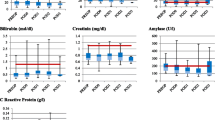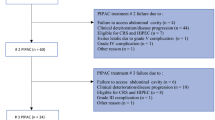Abstract
Background
Pressurized intraperitoneal aerosol chemotherapy (PIPAC) shows encouraging results for patients with unresectable peritoneal metastasis. Several reports demonstrated the safety of the procedure combined with systemic chemotherapy, with a low rate of complication. The aim of this study is to report severe hypersensitivity reactions to platinum compounds (SHRPC) during PIPAC procedures.
Methods
All patients who underwent PIPAC for non-resectable PC in Lyon Sud University hospital were included in a prospective institutional database. All patients who presented a SHRPC after PIPAC were included in our analysis.
Results
One hundred and thirty-two patients underwent 383 PIPAC procedures between December 2015 and December 2017. oxaliplatin’s and cisplatin–doxorubicin’s protocols were used in 71 and 312 PIPAC, respectively. Four patients (3%) developed SHRPC; two patients (2.8%) after oxaliplatin and two patients (0.6%) after cisplatin–doxorubicin protocols. SHRPC occurred during the 6th PIPAC with cisplatin–doxorubicin protocol and during 2nd and 3rd PIPAC of the oxaliplatin protocol. Three events appeared within 15 min and one event occurred 50 min following nebulization. All the SHRPC have been managed successfully without any complication.
Conclusions
This is the first report of SHRPC after PIPAC. The physician must constantly keep this rare but life-threatening complication in mind, especially after repeated PIPAC administration or previous platinum-based systemic chemotherapy.
Similar content being viewed by others
References
Glehen O et al (2010) Toward curative treatment of peritoneal carcinomatosis from nonovarian origin by cytoreductive surgery combined with perioperative intraperitoneal chemotherapy: a multi-institutional study of 1,290 patients. Cancer 116:5608–5618
Verwaal VJ et al (2003) Randomized trial of cytoreduction and hyperthermic intraperitoneal chemotherapy versus systemic chemotherapy and palliative surgery in patients with peritoneal carcinomatosis of colorectal cancer. J Clin Oncol 21:3737–3743
Tan HL et al (2017) Gastric peritoneal carcinomatosis—a retrospective review. World J Gastrointest Oncol 9:121–128
Elias D, Pocard M, Goere D (2007) HIPEC with oxaliplatin in the treatment of peritoneal carcinomatosis of colorectal origin. Cancer Treat Res 134:303–318
Baratti D et al (2013) Diffuse malignant peritoneal mesothelioma: long-term survival with complete cytoreductive surgery followed by hyperthermic intraperitoneal chemotherapy (HIPEC). Eur J Cancer Oxf Engl 1990 49:3140–3148
Alyami M et al (2017) Multicentric initial experience with the use of the pressurized intraperitoneal aerosol chemotherapy (PIPAC) in the management of unresectable peritoneal carcinomatosis. Eur J Surg Oncol 43:2178–2183
Grass F et al (2017) Systematic review of pressurized intraperitoneal aerosol chemotherapy for the treatment of advanced peritoneal carcinomatosis. Br J Surg 104:669–678
Robella M, Vaira M, De Simone M (2016) Safety and feasibility of pressurized intraperitoneal aerosol chemotherapy (PIPAC) associated with systemic chemotherapy: an innovative approach to treat peritoneal carcinomatosis. World J Surg Oncol 14:128
Teixeira Farinha H et al (2017) Impact of pressurized intraperitoneal aerosol chemotherapy on quality of life and symptoms in patients with peritoneal carcinomatosis: a Retrospective Cohort Study. Gastroenterol Res Pract 2017:4596176
Teixeira Farinha H et al (2018) Inflammatory response and toxicity after pressurized intraperitoneal aerosol chemotherapy. J Cancer 9:13–20
Solass W, Giger-Pabst U, Zieren J, Reymond MA (2013) Pressurized intraperitoneal aerosol chemotherapy (PIPAC): occupational health and safety aspects. Ann Surg Oncol 20:3504–3511
Demtröder C et al (2016) Pressurized intraperitoneal aerosol chemotherapy with oxaliplatin in colorectal peritoneal metastasis. Colorectal Dis 18:364–371
Nadiradze G et al (2016) Pressurized intraperitoneal aerosol chemotherapy (PIPAC) with low-dose cisplatin and doxorubicin in gastric peritoneal metastasis. J Gastrointest Surg 20:367–373
Tempfer CB et al (2015) Pressurized intraperitoneal aerosol chemotherapy in women with recurrent ovarian cancer: a phase 2 study. Gynecol Oncol 137:223–228
Basu R, Rajkumar A, Datta NR (2002) Anaphylaxis to cisplatin following nine previous uncomplicated cycles. Int J Clin Oncol 7:365–367
Ozgüroglu M, Demir G, Demirelli F, Mandel NM (1999) Anaphylaxis from intraperitoneal infusion of cisplatin: a case report. Am J Clin Oncol 22:172–173
Hebert ME, Blivin JL, Kessler J, Soper JT, Oleson JR (1995) Anaphylactoid reactions with intraperitoneal cisplatin. Ann Pharmacother 29:260–263
Solass W et al (2014) Intraperitoneal chemotherapy of peritoneal carcinomatosis using pressurized aerosol as an alternative to liquid solution: first evidence for efficacy. Ann Surg Oncol 21:553–559
Cazauran J-B et al (2018) Pressurized intraperitoneal aerosol chemotherapy (PIPAC) procedure for non-resectable peritoneal carcinomatosis (with Video). J Gastrointest Surg 22:374–375
Jacquet P, Sugarbaker PH (1996) Clinical research methodologies in diagnosis and staging of patients with peritoneal carcinomatosis. Cancer Treat Res 82:359–374
Hübner M et al (2017) Pressurized intraperitoneal aerosol chemotherapy—practical aspects. Eur J Surg Oncol 43:1102–1109
Société française d’anesthésie réanimation (2010) Prise en charge d’un choc anaphylactique. https://sfar.org/wp-content/uploads/2015/07/Choc_Anaphylactique_SFAR_2010.pdf
Boulanger J et al (2014) Management of hypersensitivity to platinum- and taxane-based chemotherapy: cepo review and clinical recommendations. Curr Oncol 21:e630–e641
Heinzerling L et al (2013) The skin prick test—European standards. Clin Transl Allergy 3:3
Stone SF, Phillips EJ, Wiese MD, Heddle RJ, Brown SG (2014) A. Immediate-type hypersensitivity drug reactions. Br J Clin Pharmacol 78:1–13
Johansson SG et al (2001) A revised nomenclature for allergy. An EAACI position statement from the EAACI nomenclature task force. Allergy 56:813–824
Brault F, Waton J, Poreaux C, Schmutz J-L, Barbaud A (2017) Hypersensitivity to platinum salts and taxanes: the value of skin tests and tolerance induction procedures. Ann Dermatol Venereol 144:685–695
Markman M et al (2003) Expanded experience with an intradermal skin test to predict for the presence or absence of carboplatin hypersensitivity. J Clin Oncol 21:4611–4614
Leguy-Seguin V et al (2007) Diagnostic and predictive value of skin testing in platinum salt hypersensitivity. J Allergy Clin Immunol 119:726–730
Weiss RB, Bruno S (1981) Hypersensitivity reactions to cancer chemotherapeutic agents. Ann Intern Med 94:66–72
Robinson JB et al (2001) Hypersensitivity reactions and the utility of oral and intravenous desensitization in patients with gynecologic malignancies. Gynecol Oncol 82:550–558
Makrilia N, Syrigou E, Kaklamanos I, Manolopoulos L, Saif MW (2010) Hypersensitivity reactions associated with platinum antineoplastic agents: a systematic review. Met Based Drugs. https://doi.org/10.1155/2010/207084
Andre : Andre T, Boni C, Mounedji-Boudiaf L et al (2004) Adjuvant chemotherapy with oxaliplatin, in combination with fluorouracil plus leucovorin prolongs disease-free survival, but causes more adverse events in people with stage II or III colon cancer Abstracted from. Multicenter international study of oxaliplatin/5-fluorouracil/leucovorin in the adjuvant treatment of colon cancer (MOSAIC) investigators. Oxaliplatin, fluorouracil, and leucovorin as adjuvant treatment for colon cancer. N Engl J Med 350:2343–2351. Cancer Treat Rev 30:711–713
Caiado J, Castells M (2015) Presentation and diagnosis of hypersensitivity to platinum drugs. Curr Allergy Asthma Rep 15:15
Miyamoto S, Okada R, Ando K (2015) Platinum hypersensitivity and desensitization. Jpn J Clin Oncol 45:795–804
Shibata Y et al (2009) Oxaliplatin-induced allergic reaction in patients with colorectal cancer in Japan. Int J Clin Oncol 14:397–401
Mertes P-M, Demoly P, Malinovsky J-M (2012) Complications anaphylactiques et anaphylactoïdes de l’anesthésie générale. EMC - Anesthésie-Réanimation 9(2):1–17
Mertes PM et al (2011) Anaphylaxis during anesthesia in France: an 8-year national survey. J Allergy Clin Immunol 128:366–373
Mertes PM et al (2010) Perioperative anaphylaxis. Med Clin North Am 94:761–789 xi
Renz CL, Thurn JD, Finn HA, Lynch JP, Moss J (1999) Antihistamine prophylaxis permits rapid vancomycin infusion. Crit Care Med 27:1732–1737
Lorenz W et al (1994) Incidence and clinical importance of perioperative histamine release: randomised study of volume loading and antihistamines after induction of anaesthesia. Trial Group Mainz/Marburg. Lancet Lond Engl 343:933–940
Otani IM, Wong J, Banerji A (2017) Platinum chemotherapy hypersensitivity: prevalence and management. Immunol Allergy Clin North Am 37:663–677
Funding
This study was not funded.
Author information
Authors and Affiliations
Corresponding author
Ethics declarations
Conflict of interest
Matthieu Siebert, Mohammad Alyami, Frederic Mercier, Colin Gallice, Laurent Villeneuve, Frédéric Bérard, Olivier Glehen, Naoual Bakrin, and Vahan Kepenekian have no conflicts of interest or financial ties to disclose.
Ethical approval
All procedures performed in studies involving human participants were in accordance with the ethical standards of the institutional and/or national research committee, and with the 1964 Helsinki declaration and its later amendments or comparable ethical standards.
Informed consent
Informed consent was obtained from all individual participants included in the study.
Rights and permissions
About this article
Cite this article
Siebert, M., Alyami, M., Mercier, F. et al. Severe hypersensitivity reactions to platinum compounds post-pressurized intraperitoneal aerosol chemotherapy (PIPAC): first literature report. Cancer Chemother Pharmacol 83, 425–430 (2019). https://doi.org/10.1007/s00280-018-3740-3
Received:
Accepted:
Published:
Issue Date:
DOI: https://doi.org/10.1007/s00280-018-3740-3




